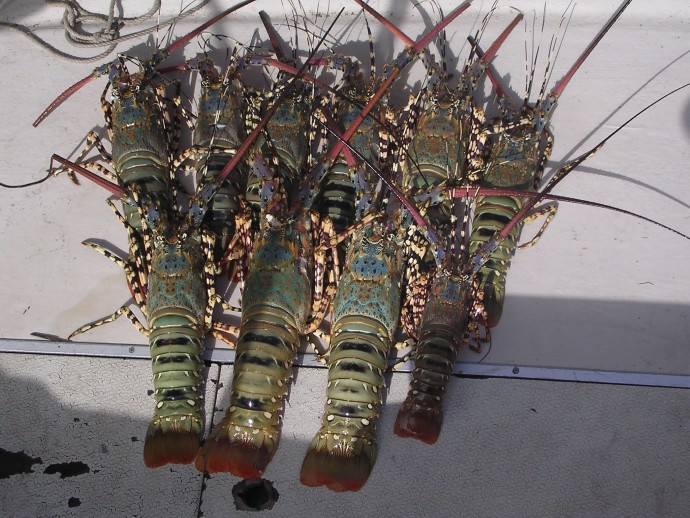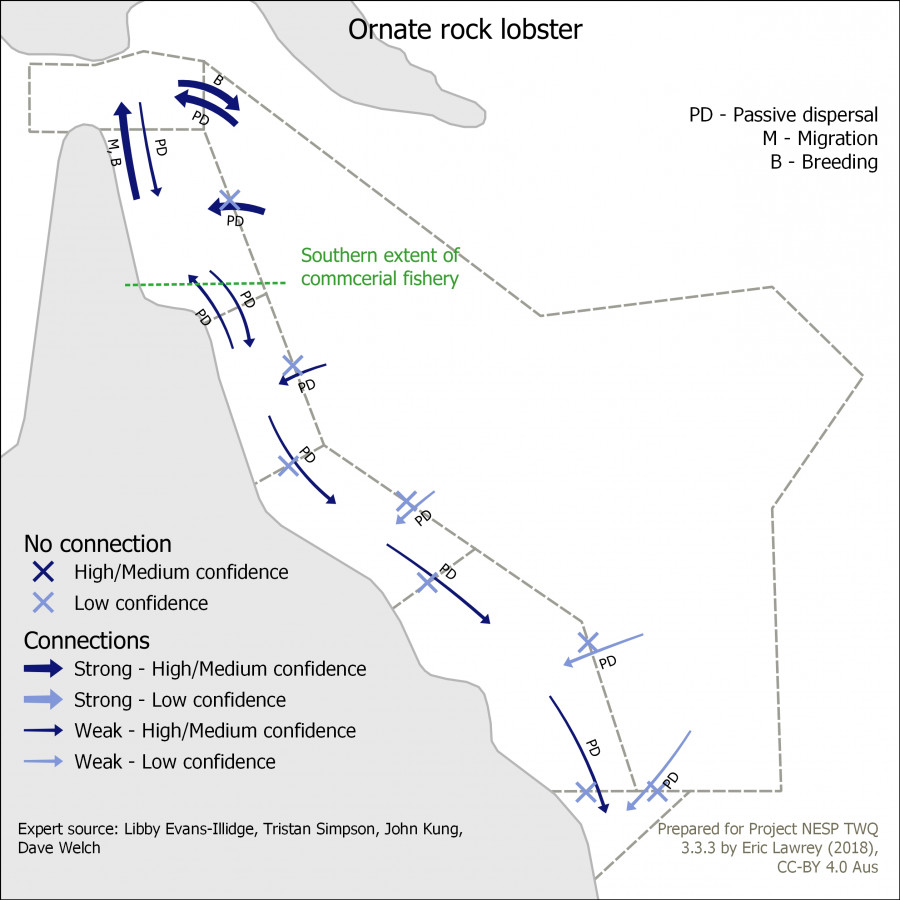Ornate rock lobster
Introduction to the Ornate rock lobster and why it is important
The Ornate rock lobster occurs in northern Australia and have a broad habitat use including deep (> 200 m) oceanic waters, reef tops and slopes, to muddy reefal areas adjacent to estuaries and river mouths, which reflects a very wide distribution (Pitcher et al. 2005). In eastern Australia they can be found as far south as Sydney however are uncommon south of the Qld/NSW border and only the east coast and Torres Strait support significant fisheries. The Australian fisheries catch is shared with Papua New Guinea and most is taken on Torres Strait. The Australian catch has been between approximately 300 and 500 t from 2011-16 however is annually variable. For example, the reported Australian catch was approximately 800 t in 2010-11. The GVP of the Australian fishery was valued at AU$14.3 million in 2015-16 (Patterson et al, 2017). They prefer reef habitat and are most common in the Torres Strait (Welch and Robins, 2014). The Queensland east coast fishery and the Torres Strait fishery have been shown to comprise the same stock (Pitcher et al. 2005).
Key concepts that relate to connectivity
The adult breeding season occurs from November-April when adults undergo an annual migration of between 70 and 500 km into deep continental shelf waters of the Coral Sea for spawning. Breeding sites include deep water (40 to 120m) areas on the continental shelf outside the Great Barrier Reef and Yule Island in the Gulf of Papua. Breeding sites on the Great Barrier Reef are predominantly in the far north however breeding sites are known to occur south to at least Townsville (19° S) (Bell et al. 1987). Lobsters that migrate to Yule Island generally do not survive after breeding (Pitcher et al. 2005).
Larvae drift in oceanic waters of the north-western Coral Sea for approximately 6 months prior to settlement. North-western Coral Sea currents are highly important for recruitment dynamics in north-eastern Australia and Torres Strait (Pitcher et al. 2005; Smith et al. 2009). There appears to be distinct regions that act as recruitment ‘sources’ and ‘sinks’ which is determined by the bifurcation of the South Equatorial Current off the Great Barrier Reef approximately adjacent to Cooktown on the north-eastern Queensland coast. Areas to the north of this bifurcation can be termed both source and sink regions and to the south as a sink region (Dennis et al. 2001; Pitcher et al. 2005). The peak timing of settlement in north-eastern Queensland occurs during winter (June-August) in most years however the seasonality of settlement is highly variable. The north-eastern Australian stock is currently assessed as sustainably fished (Maloney et al. 2016).
References
Bell, R. S., P. W. Channells, J. W. MacFarlane, R. Moore, and B.F. Phillips (1987). Movements and breeding of the ornate rock lobster. Panulirus ornatus, in Torres Strait and the northeast coast of Queensland. Aust. J. Mar. Freshw. Res., 38: 197-210.
Dennis, D. M., C. R. Pitcher & T. D. Skewes (2001). Distribution and transport pathways of Panulirus ornatus (Fabricius, 1798) and Panulirus spp. larvae in the Coral Sea, Australia. Mar. Freshwater Res. 52: 1175-1185.
Patterson, H., Noriega, R., Georgeson, L., Larcombe, J. and Curtotti, R. (2017) Fishery status reports 2017, Australian Bureau of Agricultural and Resource Economics and Sciences, Canberra. CC BY 4.0.
Pitcher, C.R., Turnbull, C.T., Atfield, J., Griffin, D., Dennis, D. and Skewes, T. (2005) Biology, larval transport modelling and commercial logbook data analysis to support management of the NE Queensland rock lobster, Panulirus ornatus, fishery. Final Report to the Fisheries Research and Development Corporation, Project # 2002/008.
Smith, G., Salmon, M., Kenway, M. and Hall, M. (2009) Description of the larval morphology of captive reared Panulirus ornatus spiny lobsters, benchmarked against wild-caught specimens. Aquaculture, 295: 76-88.
Maloney, L., Roelofs, A., Saunders, T. and de Lestang, S. (2016) Ornate rock lobster. In, Carolyn Stewardson, James Andrews, Crispian Ashby, Malcolm Haddon, Klaas Hartmann, Patrick Hone, Peter Horvat, Stephen Mayfield, Anthony Roelofs, Keith Sainsbury, Thor Saunders, John Stewart, Ilona Stobutzki and Brent Wise (eds) (2016) Status of Australian fish stocks reports 2016, Fisheries Research and Development Corporation, Canberra.
Welch, D. and Robins, J. (2014) Tropical rock lobster, Panulirus ornatus (ornate rock lobster). In: Welch, D.J., J. Robins, and T. Saunders (editors) (2014) Implications of climate change impacts on fisheries resources of northern Australia. Part 2: Species profiles. Final report to Department of Agriculture, Fisheries and Forestry, and the Fisheries Research and Development Corporation, Canberra, Australia. https://docs.wixstatic.com/ugd/9d521f_3bdc7908b0b84f25a8a17caf74903dac.pdf







